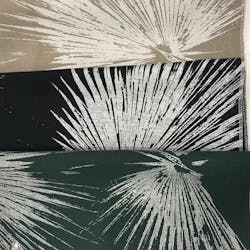While not overwhelming, particular palm motifs consistently poked their head out from around booths during this year’s HD Expo, mirroring the notifications we receive in the form of press releases: palm fronds, abstracted and repeating, have continued to be used in the industry, particularly in the hospitality market.
Interestingly, pineapples are one of the design staples brought over to the colonies from England. The fruit is said to have been brought back to Europe during Christopher Columbus' second voyage, and its many versions--from candied to jam--became a must-have in the upper echelons of society. However, access to raw and unprocessed pineapple was a luxury even those at the top of the class structure could hardly get ahold of.
Transporting the fruit in time meant it had to be shipped on the quickest boats in the fleet, and few were able to make it before turning. Therefore, it became a status symbol to be able to have the fresh fruit. Even King Charles II commissioned a portrait with a pineapple in-hand. While transportation became easier along the North American seaboard as the colonies expanded, pineapples were still a costly commodity; they quickly became a preferred high-society hostess gift, thereby cementing its on-going legacy as a symbol of hospitality.
While pineapple motifs are still used, they somewhat lost their luster in the mid-20th century when technology and materiality allowed them to be incorporated into the growing middle class through goods like wallpaper and clothing textiles. The fruit took off in popular culture, due heavily to Hawai'i becoming a state on August 21, 1959. In the same ways that America saw Egyptian motifs in the 1920s after the discovery of King Tut or Japanese-influenced design in the mid-19th century, the welcoming of Hawai'i to the United States became exoticized.
A Long History of Pineapple Motifs
It's an easy connection to say that pineapple icons evolved into the use of other tropical plants in decor, but I believe we can take it one step further to interweave the current importance of health and wellness into the reemergence of tropical prints.
As clients and end-users become more familiar with biomimicry and biophilic design, interior designers are searching for ways to bring nature indoors. With nature-inspired design on the rise, florals were reintroduced into interiors, but while pineapples mostly harken back to images of a 50’s father in a Hawaiian t-shirt next to the grill in a newly-developed suburb, florals have a tradition of easily crossing the line into appearing matronly (most likely due to gender bias, but that topic deserves its own article). Companies such as Tarkett have been able to release floral products in recent years, but they come alongside more abstracted designs to tone down the flower patterns.
Working with flowers, and working with flowers well is a special skill few possess.
Tropical motifs, however, haven't had the same type of gender bias that flowers have. The historical tie-in to hospitality may not be as direct as it was in the past, but the image of palms, pineapples, and birds of paradise still inspire the feeling of luxury, relaxation, and getting away from it all. Eliciting these emotions while also pulling in biophilic design principals packages the whole aesthetic into the perfect "Wish you were here!" statement.
Two notable instances during the HD Expo show were the use of more mid-century design and repeat by Innovations, and an abstracted block-print-like design by Fil Doux. In particular, these two examples show the main ways in which interior designers are using tropical greenery: in traditional, realistic ways (Innovations), or by breaking down the pattern to only its geometric elements (Fil Doux).
Designers can expect to continue to see pineapples, palms, and more tropically-integrated products in the coming years. While they may not take center-stage or be the highlight of the collection, they will continue to emerge.
About the Author

Kadie Yale
Former Editor-in-Chief
Kadie Yale holds a BA in Industrial Design from San Francisco State University and a MA in Decorative Art History and Theory from Parsons the New School. In her role as editor-in-chief from 2015-2018, she led the interiors+sources team in creating relevant content that touches on sustainability, universal design, science, and the role of design in society.
